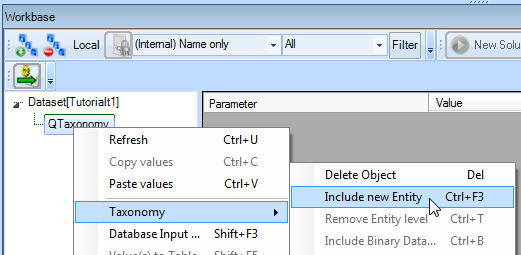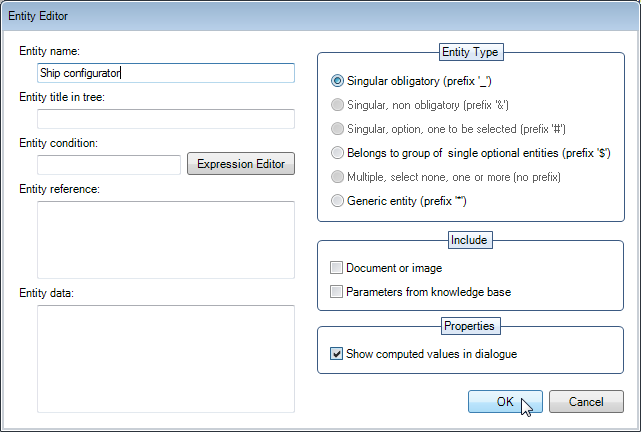Page History
You are now going to create the first entity in the newly created taxonomy.
- Right-click on the
QTaxonomynode in the Workbase and select Taxonomy... -> Include new Entity, or press Ctrl+F3:
2.1 Include first singular obligatory Entity “Ship configurator”
To create the first Entity in your Taxonomy, first select the QTaxonomy object in the Workbase. Select the right mouse button menu Taxonomy>Include new Entity or press Ctrl+F3, see Figure 40. This opens the Entity Editor, see Figure 41.
Figure 40: Include new Entity
Figure 41: Entity editor
The Entity Editor contains Entity properties fields, Entity include/properties options and Entity type options. For the explanation of the fields and properties we refer to “Knowledge Engineering getting started course Part 2”.
The The Entity Type of first Entity in a Taxonomy tree, can only be 'Singular obligatory that '. This means that this Entity this Entity will always be included during included in a dialoguedialog.
- Provide the
...
- name
Ship configurator
...
- in the field Entity Name and click OK.
Name and press “OK”. Now your first Entity is placed in the Taxonomy tree within the Workbase below QTaxonomy object, see Figure 42.below QTaxonomy object (note again that this is in the Workbase):
Every Entity automatically contains the standard Quaestor parameters: QEntityName and QEntityID. Both parameters will not be visible during a process dialogue dialog for users. The unique value for QEntityID is automatically given by Quaestor and for QEntityID is unique and is automatically assigned by Quaestor. It cannot be modified by a Knowledge Engineer.
In front of the Name in QEntityName you can see The value of QEntityName is automatically prepended with a prefix that indicates the type of Entity (in this case “_”, which means singular obligatory Entity). Each Entity type has his its own specific prefix. To change the name of an Entity you have to rename the Name within QEntitname.However
| Note |
|---|
When renaming an entity, be aware that changing the prefix will also change the behavior of the Taxonomy tree! |
Figure 42: Include first singular obligatory Entity "Ship configurator"
...
| Info |
|---|
Values filled in the |
...
fields |
...
of the Entity Editor can always be included/edited |
...
later on. |
Back to content | Continue with Include optional Entities Next >>





